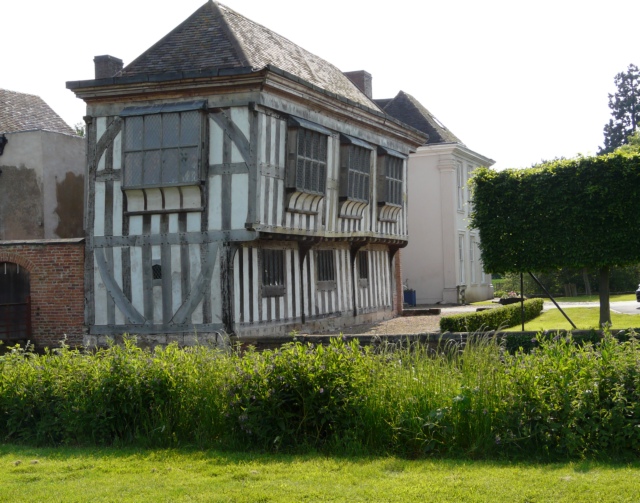|
Megachile Willughbiella and ''Megachile willughbiella'', Willughby's leaf-cutter bee is a species of bee in the family Megachilidae. It was described by the English entomologist William Kirby in 1802; he named it in honour of the ornithologist Francis Willughby. Description ''Megachile willughbiella'' is a leafcutter bee found in gardens and brownfield areas especially in cities. The nest is built in soil or in wood; the cells are made of leaves. The species has kleptoparasites from the leafcutting cuckoo bee genus ''Coelioxys'', such as ''C. quadridentata'', ''C. rufescens'' and ''C. elongata''. Pollen is collected from a wide variety of flowers including Asteraceae, Fabaceae The Fabaceae or Leguminosae,International Code of Nomenc ... [...More Info...] [...Related Items...] OR: [Wikipedia] [Google] [Baidu] |
William Kirby (entomologist)
William Kirby (19 September 1759 – 4 July 1850) was an English entomologist, an original member of the Linnean Society and a Fellow of the Royal Society, as well as a country rector, so that he was an eminent example of the "parson-naturalist". The four-volume ''Introduction to Entomology'', co-written with William Spence, was widely influential. Family origins and early studies Kirby was a grandson of the Suffolk topographer John Kirby (author of ''The Suffolk Traveller'') and nephew of artist-topographer Joshua Kirby (a friend of Thomas Gainsborough's). He was also a cousin of the children's author Sarah Trimmer. His parents were William Kirby, a solicitor, and Lucy Meadows. He was born on 19 September 1759 at Witnesham, Suffolk, and studied at Ipswich School and Caius College, Cambridge, where he graduated in 1781. Taking holy orders in 1782, he spent his entire working life in the peaceful seclusion of an English country parsonage at Barham in Suffolk, working at th ... [...More Info...] [...Related Items...] OR: [Wikipedia] [Google] [Baidu] |
Megachilidae
Megachilidae is a cosmopolitan family of mostly solitary bees. Both that their pollen-carrying structure (called a ''scopa'') is restricted to the ventral surface of the abdomen (rather than mostly or exclusively on the hind legs as in other bee families), and their typically elongated labrum is characteristic of this family. C. D. Michener (2007) ''The Bees of the World'', 2nd Edition, pg. 122, Johns Hopkins University Press. Megachilid genera are most commonly known as mason bees and leafcutter bees, reflecting the materials from which they build their nest cells (soil or leaves, respectively); a few collect plant or animal hairs and fibers, and are called carder bees, while others use plant resins in nest construction and are correspondingly called resin bees. All species feed on nectar and pollen, but a few are kleptoparasites (informally called "cuckoo bees"), feeding on pollen collected by other megachilid bees. Parasitic species do not possess scopae. The motion of Meg ... [...More Info...] [...Related Items...] OR: [Wikipedia] [Google] [Baidu] |
Species Description
A species description is a formal description of a newly discovered species, usually in the form of a scientific paper. Its purpose is to give a clear description of a new species of organism and explain how it differs from species that have been described previously or are related. In order for species to be validly described, they need to follow guidelines established over time. Zoological naming requires adherence to the ICZN code, plants, the ICN, viruses ICTV, and so on. The species description often contains photographs or other illustrations of type material along with a note on where they are deposited. The publication in which the species is described gives the new species a formal scientific name. Some 1.9 million species have been identified and described, out of some 8.7 million that may actually exist. Millions more have become extinct throughout the existence of life on Earth. Naming process A name of a new species becomes valid (available in zo ... [...More Info...] [...Related Items...] OR: [Wikipedia] [Google] [Baidu] |
Francis Willughby
Francis Willughby (sometimes spelt Willoughby, la, Franciscus Willughbeius) FRS (22 November 1635 – 3 July 1672) was an English ornithologist and ichthyologist, and an early student of linguistics and games. He was born and raised at Middleton Hall, Warwickshire, the only son of an affluent country family. He was a student at Trinity College, Cambridge, where he was tutored by the mathematician and naturalist John Ray, who became a lifetime friend and colleague, and lived with Willughby after 1662 when Ray lost his livelihood through his refusal to sign the Act of Uniformity. Willughby was elected as a Fellow of the Royal Society in 1661, then aged 27. Willughby, Ray, and others such as John Wilkins were advocates of a new way of studying science, relying on observation and classification, rather than the received authority of Aristotle and the Bible. To this end, Willughby, Ray and their friends undertook a number of journeys to gather information and specimens, ini ... [...More Info...] [...Related Items...] OR: [Wikipedia] [Google] [Baidu] |
Kleptoparasite
Kleptoparasitism (etymologically, parasitism by theft) is a form of feeding in which one animal deliberately takes food from another. The strategy is evolutionarily stable when stealing is less costly than direct feeding, which can mean when food is scarce or when victims are abundant. Many kleptoparasites are arthropods, especially bees and wasps, but including some true flies, dung beetles, bugs, and spiders. Cuckoo bees are specialized kleptoparasites which lay their eggs either on the pollen masses made by other bees, or on the insect hosts of parasitoid wasps. They are an instance of Emery's rule, which states that insect social parasites tend to be closely related to their hosts. The behavior occurs, too, in vertebrates including birds such as skuas, which persistently chase other seabirds until they disgorge their food, and carnivorous mammals such as spotted hyenas and lions. Other species opportunistically indulge in kleptoparasitism. Strategy Kleptoparasitism is a ... [...More Info...] [...Related Items...] OR: [Wikipedia] [Google] [Baidu] |
Cuckoo Bee
The term cuckoo bee is used for a variety of different bee lineages which have evolved the kleptoparasitism, kleptoparasitic behaviour of laying their eggs in the nests of other bees, reminiscent of the behavior of cuckoo birds. The name is perhaps best applied to the apidae, apid subfamily Nomadinae, but is commonly used in Europe to mean bumblebees ''List of bumblebee species, Bombus'' subgenus ''Psithyrus''. Females of cuckoo bees are easy to recognize in almost all cases, as they lack pollen collecting structures (the scopa (biology), scopa) and do not construct their own nests. They often have reduced body hair, abnormally thick and/or heavily sculptured exoskeleton, and saber-like mandible (insect), mandibles, although this is not universally true; other less visible changes are also common. They typically enter the nests of pollen-collecting species, and lay their eggs in cells provisioned by the host bee. When the cuckoo bee larva hatches it consumes the host larva's pollen ... [...More Info...] [...Related Items...] OR: [Wikipedia] [Google] [Baidu] |
Coelioxys
''Coelioxys'', common name leaf-cutting cuckoo bees or sharp-tailed bees , is a genus of solitary kleptoparasitic or brood parasitic bees, belonging to the family Megachilidae. Diversity The genus includes about 500 species in 15 subgenera. Selected species * '' Coelioxys angulata'' * '' Coelioxys apicata'' * '' Coelioxys capitata'' * '' Coelioxys fenestrata'' * '' Coelioxys formosicola'' * '' Coelioxys fuscipennis'' * '' Coelioxys minuta'' * '' Coelioxys nitidoscutellaris'' * '' Coelioxys rufitarsis'' * '' Coelioxys sodalis'' For a complete list, see List of ''Coelioxys'' species. Distribution ''Coelioxys'' species can be found in most European countries, in the Afrotropical realm, in the East Palearctic realm, in North Africa, in the Nearctic and Neotropics. Description Bees within this genus can reach a length of . They show a broad head with large complex eyes and broad thorax and abdomen. Their body is only moderately hairy. They are usually black with white h ... [...More Info...] [...Related Items...] OR: [Wikipedia] [Google] [Baidu] |
Pollen
Pollen is a powdery substance produced by seed plants. It consists of pollen grains (highly reduced microgametophytes), which produce male gametes (sperm cells). Pollen grains have a hard coat made of sporopollenin that protects the gametophytes during the process of their movement from the stamens to the pistil of flowering plants, or from the male cone to the female cone of gymnosperms. If pollen lands on a compatible pistil or female cone, it germinates, producing a pollen tube that transfers the sperm to the ovule containing the female gametophyte. Individual pollen grains are small enough to require magnification to see detail. The study of pollen is called palynology and is highly useful in paleoecology, paleontology, archaeology, and forensics. Pollen in plants is used for transferring haploid male genetic material from the anther of a single flower to the stigma of another in cross-pollination. In a case of self-pollination, this process takes place from the anth ... [...More Info...] [...Related Items...] OR: [Wikipedia] [Google] [Baidu] |
Asteraceae
The family Asteraceae, alternatively Compositae, consists of over 32,000 known species of flowering plants in over 1,900 genera within the order Asterales. Commonly referred to as the aster, daisy, composite, or sunflower family, Compositae were first described in the year 1740. The number of species in Asteraceae is rivaled only by the Orchidaceae, and which is the larger family is unclear as the quantity of extant species in each family is unknown. Most species of Asteraceae are annual, biennial, or perennial herbaceous plants, but there are also shrubs, vines, and trees. The family has a widespread distribution, from subpolar to tropical regions in a wide variety of habitats. Most occur in hot desert and cold or hot semi-desert climates, and they are found on every continent but Antarctica. The primary common characteristic is the existence of sometimes hundreds of tiny individual florets which are held together by protective involucres in flower heads, or more technicall ... [...More Info...] [...Related Items...] OR: [Wikipedia] [Google] [Baidu] |
Fabaceae
The Fabaceae or Leguminosae,International Code of Nomenclature for algae, fungi, and plants. Article 18.5 states: "The following names, of long usage, are treated as validly published: ....Leguminosae (nom. alt.: Fabaceae; type: Faba Mill. Vicia L.; ... When the Papilionaceae are regarded as a family distinct from the remainder of the Leguminosae, the name Papilionaceae is conserved against Leguminosae." English pronunciations are as follows: , and . commonly known as the legume, pea, or bean family, are a large and agriculturally important of |
Onagraceae
The Onagraceae are a family of flowering plants known as the willowherb family or evening primrose family. They include about 650 species of herbs, shrubs, and treesOnagraceae. Flora of China. in 17 genera. The family is widespread, occurring on every continent from boreal to regions. The family includes a number of popular plants, including evening primroses ('''') and [...More Info...] [...Related Items...] OR: [Wikipedia] [Google] [Baidu] |
Campanulaceae
The family Campanulaceae (also bellflower family), of the order Asterales, contains nearly 2400 species in 84 genera of herbaceous plants, shrubs, and rarely small trees, often with milky sap. Among them are several familiar garden plants belonging to the genera '' Campanula'' (bellflower), ''Lobelia'', and ''Platycodon'' (balloonflower). ''Campanula rapunculus'' (rampion or r. bellflower) and ''Codonopsis lanceolata'' are eaten as vegetables. ''Lobelia inflata'' (indian tobacco), '' L. siphilitica'' and '' L. tupa'' (devil's tobacco) and others have been used as medicinal plants. ''Campanula rapunculoides'' (creeping bellflower) may be a troublesome weed, particularly in gardens, while ''Legousia'' spp. may occur in arable fields. Most current classifications include the segregate family Lobeliaceae in Campanulaceae as subfamily Lobelioideae. A third subfamily, Cyphioideae, includes the genus ''Cyphia'', and sometimes also the genera ''Cyphocarpus'', ''Nemacladus'', ''Parishell ... [...More Info...] [...Related Items...] OR: [Wikipedia] [Google] [Baidu] |




